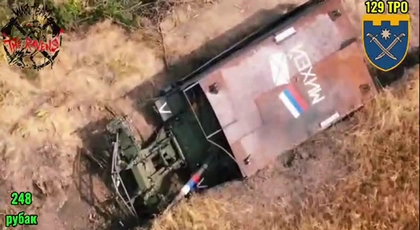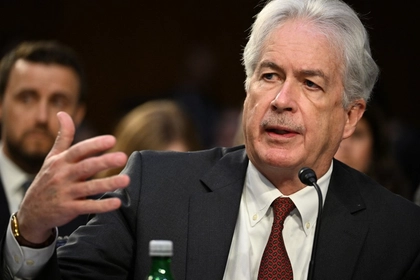President Vladimir Putin ordered his armed forces to cleanse Russia of every single invading soldier no later than the end of September, but that didn’t happen and by some measures, the situation in Russia’s Kursk region is getting worse.
Multiple Ukrainian combat brigades were on Tuesday, as the timeline for that presidential decree ran out, still deployed in force in Russia, 45 days into Kyiv’s incursion into Russian territory, in two small enclaves and a single Luxembourg-sized salient.
JOIN US ON TELEGRAM
Follow our coverage of the war on the @Kyivpost_official.

Russian troops to the west of the Ukrainian incursion were, on Tuesday, still partially isolated by the Ukraine-Russia border and an unfordable river called the Seym, and able to receive only limited supply under fire by Ukrainian artillery and kamikaze drones. The deteriorating Russian situation was first reported by Kyiv Post among other Ukrainian media in early September.
As October begins, back-and-forth battles are still taking place at flashpoints along a roughly 115- to 125-kilometer (71- to 77-mile) perimeter held by Ukraine inside Russia, with neither side holding a clear upper hand, and both sides attempting to gain ground.

Ukraine’s Usyk Beats Fury in Heavyweight Championship Rematch
The firefights and artillery exchanges have pitted elements of Russian paratroopers and naval infantry “marine” formations, backed by Russia’s powerful air force, against the largest-scale Ukrainian offensive force assembled since June 2023.
Russia reportedly has deployed up to 40,000 troops to the Kursk sector to stamp out the Ukrainian incursion. Per Kremlin statements and according to Ukraine-based open-source researchers, Kyiv has deployed elements of some 30 combat brigades – on paper at least a quarter of the entire Ukrainian army – for Ukraine’s invasion of Russia.
Per reports from units involved in the fighting, the latest round of Ukrainian Kursk sector attacks kicked off on Sept. 25-26 and were aimed at the town of Glushkovo.
Ukrainian capture of the town would split the isolated sector roughly in half. Kremlin information platforms reported those attacks were repelled with losses.
Some Ukrainian social media on Tuesday said Kyiv’s forces had fought their way into Glushkovo’s southern suburbs, and published video of Russian air and artillery strikes geo-located to that area – usually a reliable indicator of Ukrainian troops in the vicinity.
Kyiv Post review of Tuesday images collected by the NASA satellite network NISI showed fires burning to the north of Glushkovo in the vicinity of one of the Seym River crossing sites. Very substantial fires were visible further upstream, deeper into Russia-controlled territory, near the riverside villages of Iznoskovo, Imenny Kubysheva, and Semenovo.

Russian sources, including the Ministry of Defense, on Tuesday claimed Kremlin forces made assaults into Ukraine-controlled territory southeast of the town of Korenevo and south of the town Sudzha, and in the vicinity of a village called Plekhova, at the southeastern base of the Ukrainian salient, and scored alleged substantial ground gains on Sunday and Monday.
A Ukrainian unit geo-located to that sector, the 129th Territorial Defense on Sunday published a video contradicting that Kremlin narrative, showing images of Russian armored assault of at least five tanks and armored personnel carriers driving across open fields near Plekhova, and being stopped and burned by accurate Ukrainian artillery and drone swarm strikes.
The Ukrainian Armed Forces (AFU) official Telegram channel called the Russian losses geo-located to the vicinity of Plekhovo: “Very powerful images of Ruskies in the Kursk region getting f****d up by pilots of the 129th Territorial Defense Brigade.”
Putin, in response to initial Ukrainian incursions in mid-August, named his alma mater, Russia’s national spy agency the Federal Security Service (FSB), the lead for containing and repelling Ukraine’s invasion.
National-level special operations units not often spotted in action in Ukraine deployed to the Kursk region to beef up defenses, among them the famous FSB Spetsnaz commandoes and the Alpha and Vymel anti-terrorist strike groups, the Institute for the Study of War (ISW) reported in a Sept. 26 situation update.
Those elite units, though skilled in infantry tactics went into combat again with little experience coordinating with other state agencies like the army, air force, and national police, and sometimes found themselves at a disadvantage fighting against heavily armed Ukrainian combat brigades fielding tanks, infantry fighting vehicles, artillery and dedicated drone units.
“Friction” between the FSB and other agencies tasked to expel Ukraine’s military from the Kursk region is likely to continue, the ISW report said.
Aleksei Dyumin, a top-level Putin advisor, on Sept. 27, insisted the Russian counter-offensive would deliver results, telling state-controlled media: “Soon all that territory (in Kursk region) will be completely liberated. The General Staff has a plan for that.”
According to Ukrainian sources, Russian generals, despite such promises, were not only far from ejecting the Ukrainian incursion but struggling to keep 2-3,000 troops partially isolated by the advance of Kyiv forces supplied.
As of Sept. 29, a single pontoon bridge across the Seym River was still intact and in use by Kremlin troops for continued delivery of food and ammunition to Russian forces in a 900-square-kilometer (348-square-mile) swath of territory west of the Ukrainian incursion, but reachable for Russian forces only via routes crossing the river, the Ukrainian open-source data tracker KybrBroshono reported.
Ukrainian reconnaissance drones reportedly are in near-continuous orbit above the now-vital span some 3 kilometers (1.9 miles) north the of village of Glushkovo, and traffic using the bridge at times must run a gauntlet of long-range Ukrainian artillery shell strikes or FPV drones.
Since Ukraine invaded the Kursk region, Kyiv’s forces destroyed three road bridges and three pontoon bridges along the Seym, the report said. Kyiv Post researchers confirmed the Ukrainian air force used Western-ally-delivered guided bombs to take down at least two of the road bridges.
Both sides over the weekend reported continued intense Russian artillery and air bombardment of suspected Ukrainian positions inside Russia.
“As for shelling, they saturate us with everything they have. This isn’t even mentioning the glider bombs. They make strikes on the ‘fire column’ principle. That is, they start out from the simple principle that there are no and nor can there be any of their civilians in the villages we have occupied. Therefore, they can flatten everything level with the ground,” said Kyrylo Sazonov, a Ukrainian military officer and milblogger.
Military analyst Donald Hill in a Sept. 30 situation report said that six out of every ten glider bombs dropped by the Russian Air Force every day are aimed at targets inside the Kursk region. Sazonov put the daily figure at 40-50 guided bombs, all launched by strike aircraft operating outside the range of Ukrainian air defenses.
On Sept. 20 Russian Foreign Ministry speaker Mariya Zakharova (L) told the state-run TASS news agency that the Kremlin had “reliable information” that Ukrainian troops had converted an old person’s home in the Kursk region city of Sudzha into a concentration camp and were abusing civilians detained there. On Sept. 26, Ukraine’s Territorial Defense Forces, the main Ukrainian military formation responsible for rear area security, published a video from the Sudzha Internat.
Residents of the old person home in the Ukraine-produced content said the Zakharova’s comments were groundless and that Ukrainian troops were assisting Russian civilians with food, water, and medical care.
“F**k, what a bitch! It's 100% a lie!” one Sudzha resident said of Zakharova’s claims about concentration camps in his town, in the Kyiv-produced video.

A Kyiv Post reporter visiting Sudzha found a stable situation and no evidence of abuse of Russian civilians by Ukrainian troops.
You can also highlight the text and press Ctrl + Enter







